Affiliate links on Android Authority may earn us a commission. Learn more.
Razer Phone vs OnePlus 5T: which spec powerhouse comes out on top?
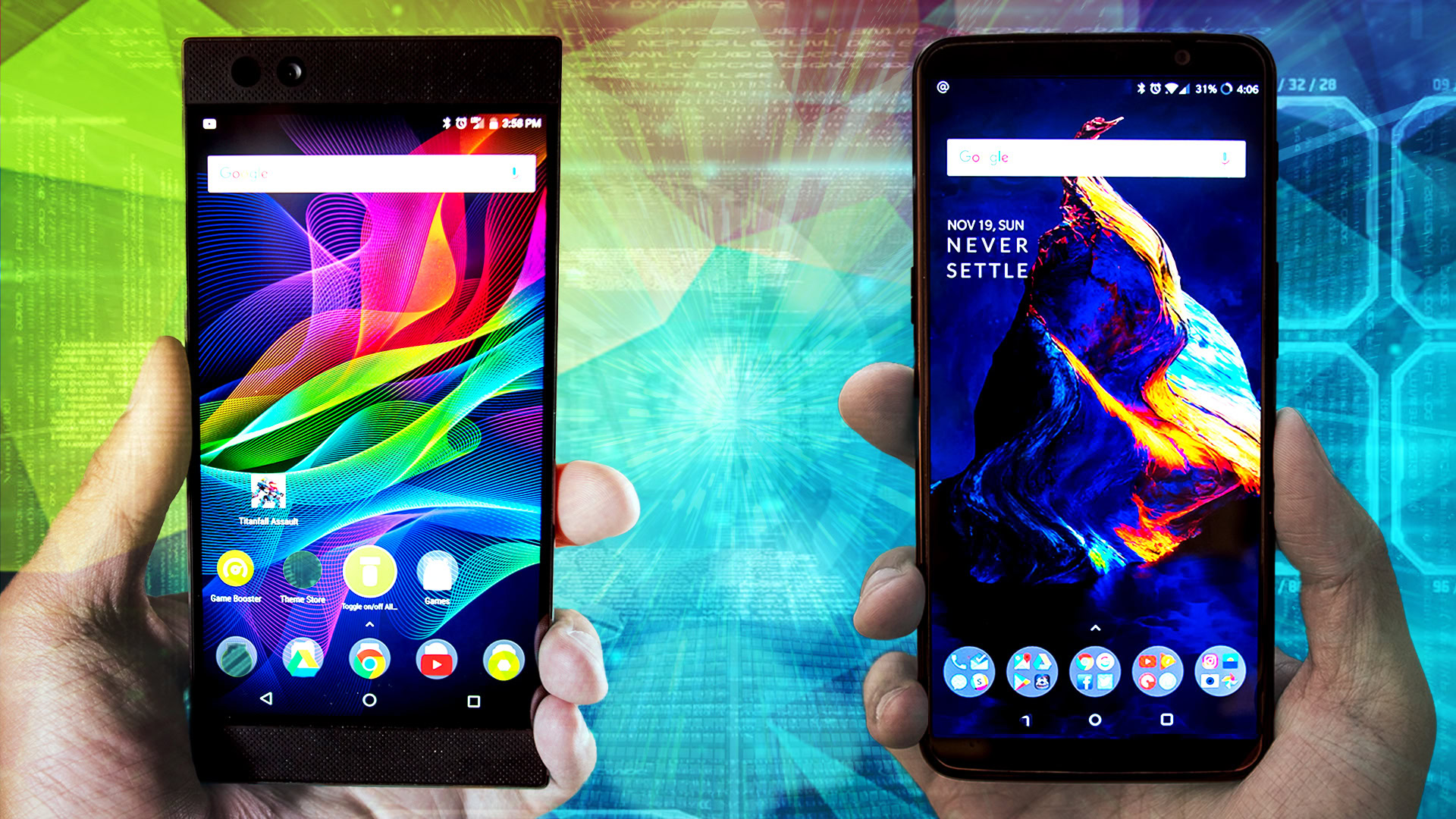
2017 has brought us some fantastic smartphones. But if you’re looking for a phone that makes little-to-no sacrifice on the spec sheet, two stand out above the rest.
The Razer Phone and the OnePlus 5T absolutely crush the competition on paper (with the exception of a few areas), but there is a lot that separates these two powerhouse phones. See which phone comes out on top in this Razer Phone vs OnePlus 5T comparison.
Design
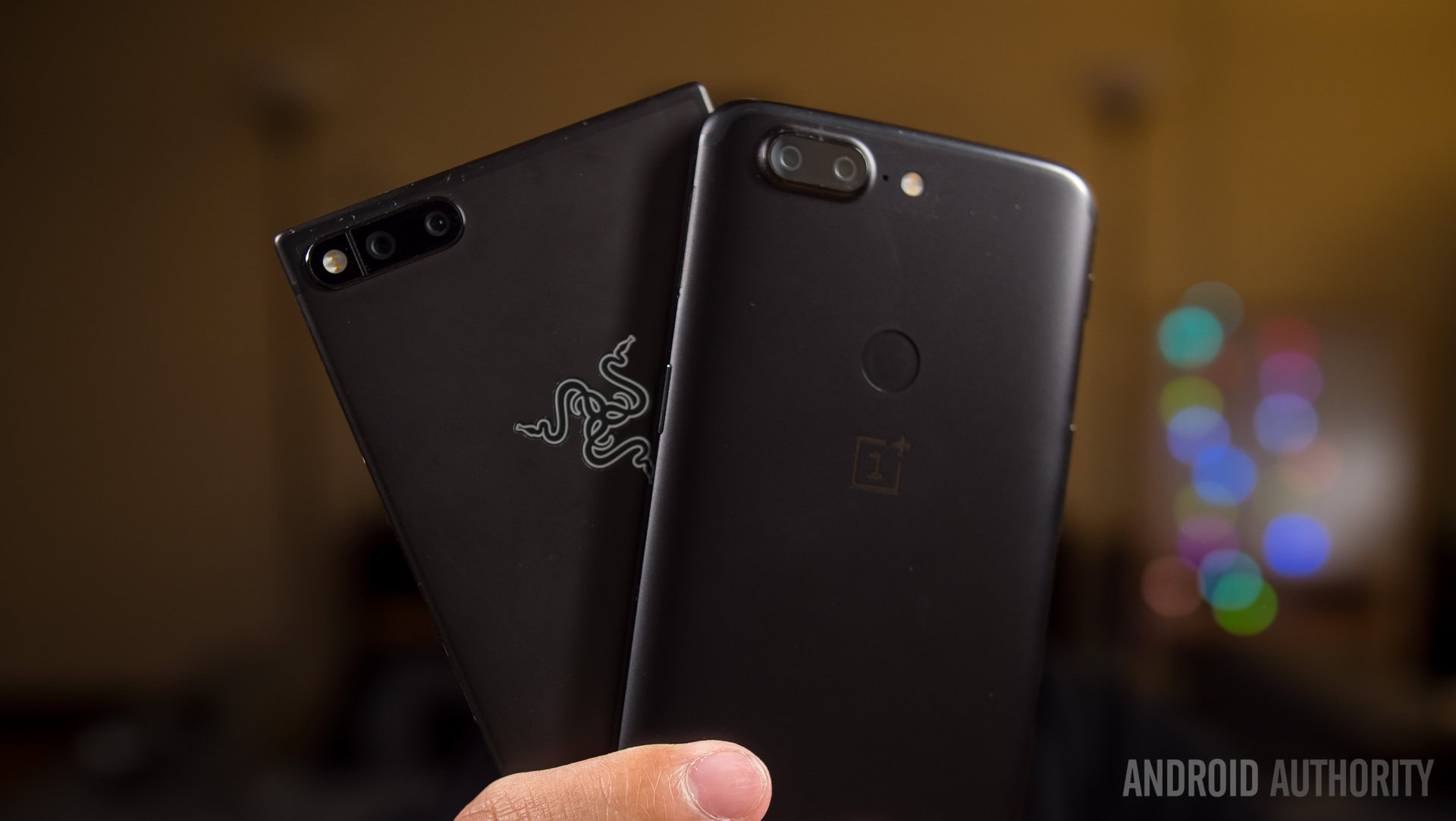
These phones take very different approaches to design, with the Razer Phone basically resurrecting the aesthetic of the Nextbit Robin and putting a coat of Razer paint on top. The result is a matte black slate with sharp corners and flat sides all around. Aside from the sheer size of the phone, which doesn’t lend itself to the best one-handed usage, it’s hard not to like the blocky form factor that we no longer see across the smartphone market these days.
Don’t miss: Razer Phone review | OnePlus 5T review
Which is where the OnePlus 5T comes in, the metal slab that updates the continued design language that was started in the OnePlus 3. Smooth metal is the motif here, but a smaller and more accessible size is also a feather in its cap. OnePlus continues to put as much as it can, including a headphone jack, in a phone that is delightfully thin. Other features like the Alert Slider return, though the fingerprint reader has been moved to the back in a more accessible place, compared to the sensor embedded in the power button of the Razer.

It’s almost funny to see a plastic phone called the Razer go up against the OnePlus metallic design – but in their own ways, both phones are very visually appealing. The Razer logo on the back will likely attract even remote fans of the gaming brand, while the 5T remains unassuming at first and then gets compliments for how sleek it looks. But if handling is going to be a big deal to you, the OnePlus 5T is definitely a bit easier on the hands.
Display
Part of what makes the OnePlus so easy to handle is the 18:9 Full HD AMOLED screen that the 5T rocks across its entire front. OnePlus did well to remove the front facing home button and fingerprint reader in order to make room for all that screen. It looks pretty great too, despite the lower resolution – OnePlus did a great job optimizing how Oxygen OS looks on its display. There are a few features in the display that really add to its appeal, like the well-done Always on Display and OnePlus’ own version of the Night Light. One feature we’ll always enjoy on here is the Reading Mode, that actually changes the display to effectively emulate an e-paper screen – a feature that is literally easier on the eyes.
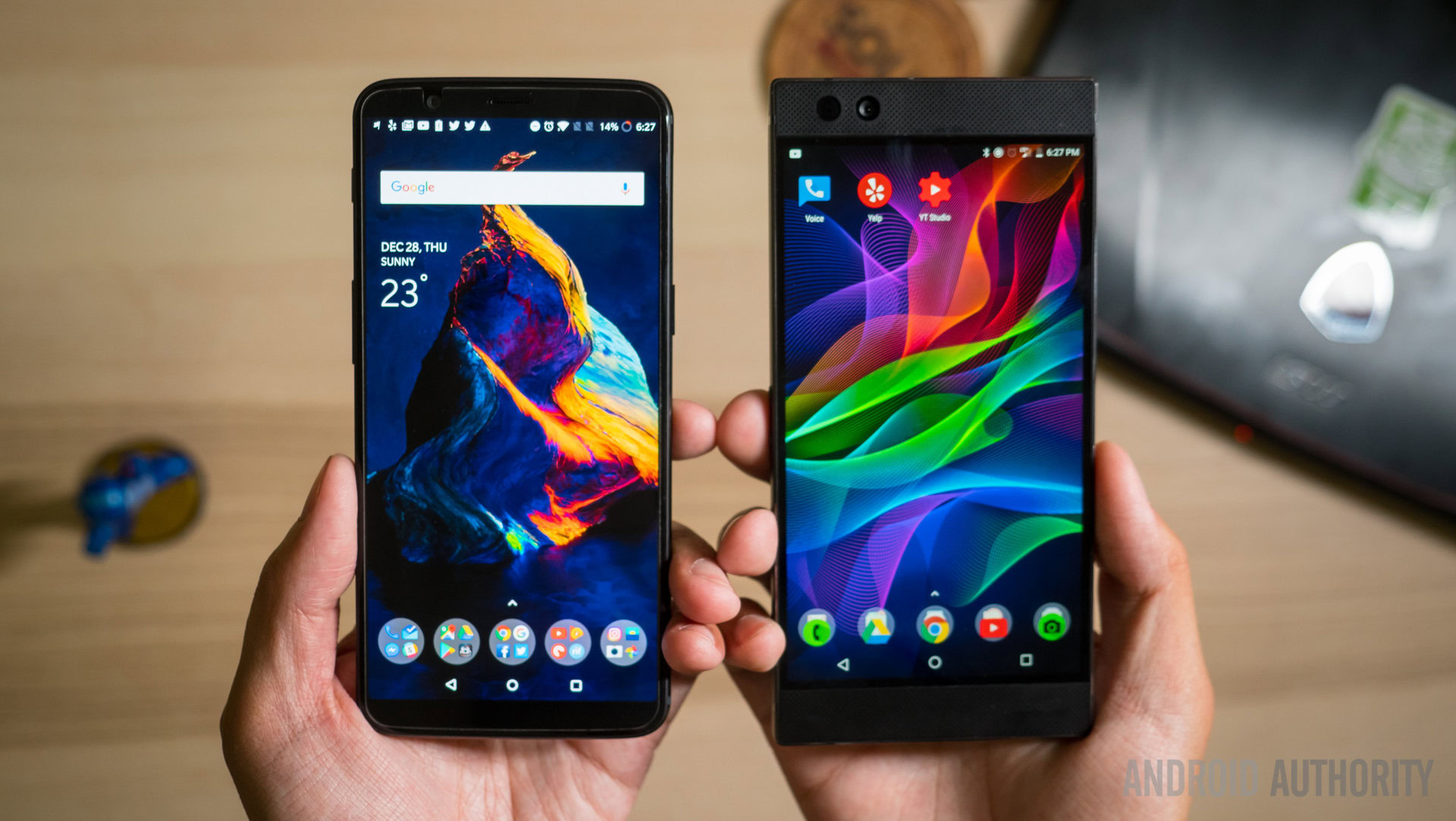
None of these features are available on the Razer Phone IPS Quad HD 16:9 display, but Razer was not to be outdone. Taking inspiration from their laptop screens, the Razer rocks a panel capable of high refresh rates to go along with its support of high frame rate content. Put together, this is called Ultramotion, and it is pretty incredible. Syncing the GPU with the refresh rate of the display makes for the best possible motion rendering no matter what content is being consumed – anything from 60 fps video to 120 fps high quality games to near-zero on the static homescreens. It’s hard not to see these enhancements when put up against another screen, and in this comparison the Razer Phone is just smoother than its competition.
With all that said, the Razer IPS screen doesn’t seem to get as bright as it should at 100% and its color reproduction could use a bit more punch compared to the OnePlus AMOLED display. But, Ultramotion is something we would love to see implemented more throughout smartphones, and Razer just might have started that trend.
Performance & hardware
Up until this point, there are very clear differences between these two phones, but, when getting underneath the very different screens, these two stories start to converge. Performance is not lacking in either of these phones, with the Snapdragon 835 getting backed up by a great amount of RAM at 8 GB. Few phones in the West actually hit these specs and it is a configuration we often see in Asia, but the spec hungry have two pretty great options here. Razer also allows the user a little extra control over the speed and power of the phone with the Game Booster, where even the clock speed of the processor can be catered to high performance or battery saving levels.
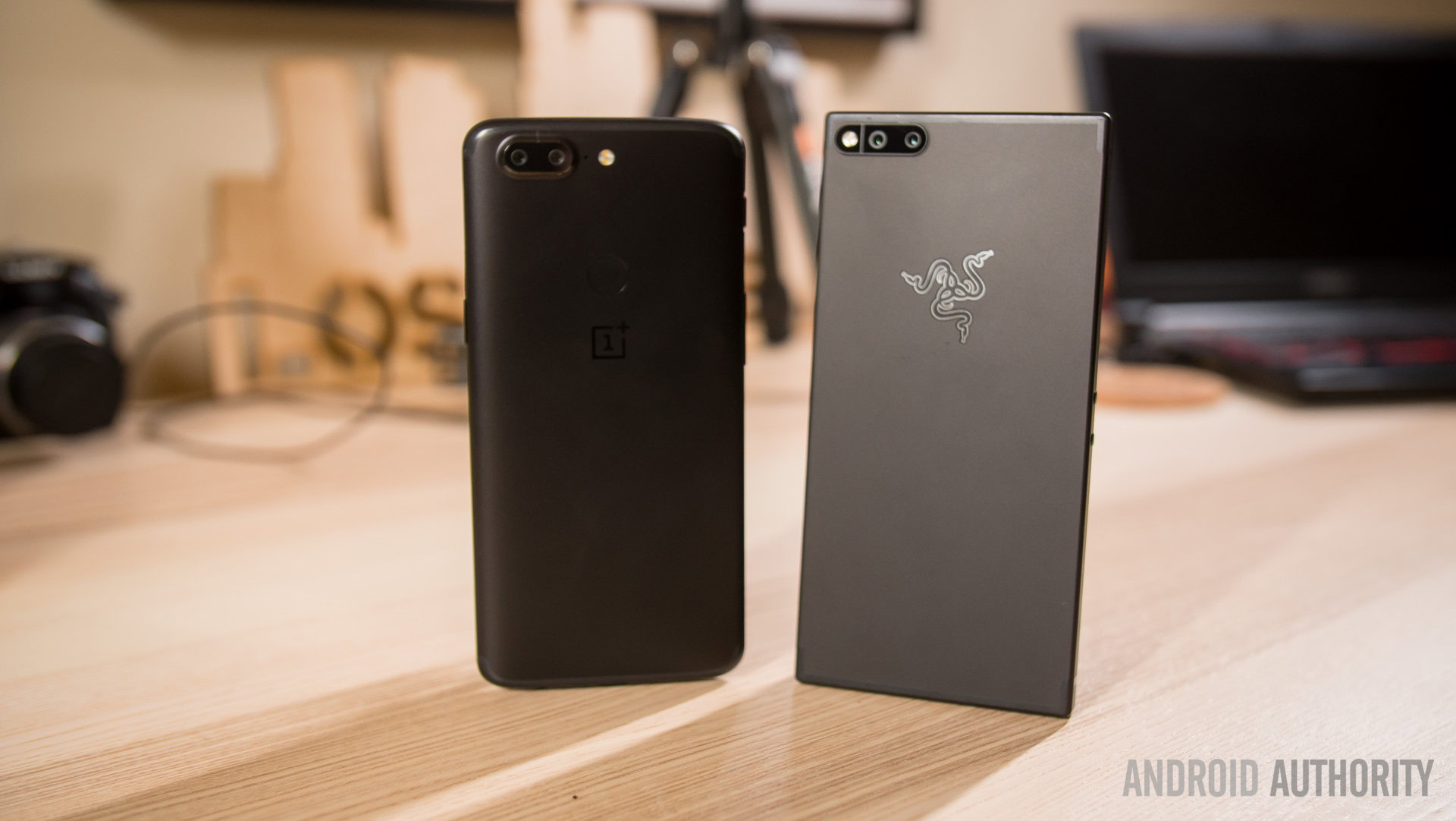
Storage is a little bit of a different story, however, with the Razer packing 64 GB that can be expanded with a microSD card. This is not the case with the OnePlus 5T, as it doesn’t allow for storage expansion but comes with a ton at 128 GB in the higher-end model.
Sound is a give-and-take, however, as the OnePlus 5T does keep the headphone jack while the Razer Phone puts it in an adapter that goes in the lone USB Type-C port. Many users might not enjoy this design choice by Razer, but they at least installed a 24-bit DAC in the adapter – with a good pair of headphones, the wired listening experience gets a huge boost. The front facing speakers on the Razer are also some of the best that we’ve ever heard, managing to get really loud without clipping the highs or going overboard on the lows. It is even loud enough to replace small Bluetooth speakers. It comes down to priorities in this case – those who actually want a loud speaker phone can go with the Razer, while anyone standing firm on the inclusion of headphone jacks will prefer the OnePlus.
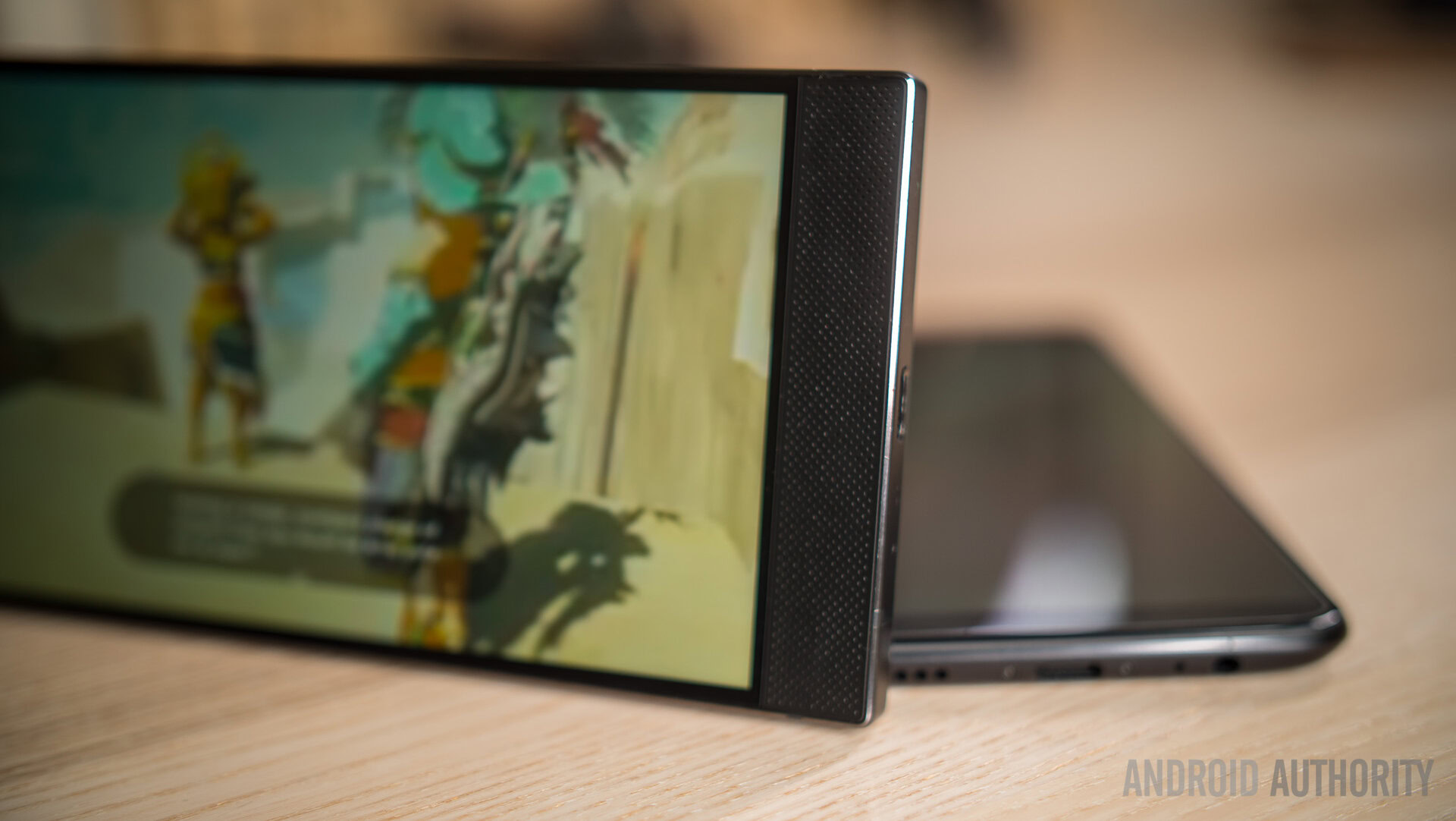
Cameras
Dual cameras are the case in either of these phones, but there are differing philosophies. The Razer Phone rocks dual 12 MP lenses, with the wider lens sporting f/1.8 aperture and the telephoto lens bumping that up to f/2.6.
While it has been well documented that the Razer Phone is severely lacking in camera software, features, and to some extent quality, there has since been an update that hopes to rectify some of those issues. I did get the update and decided to use this comparison as the time to test it out. The camera update makes the stock camera indicate which lens is in use, but there is little else added into the actual feature set – certainly no portrait mode, which is prominently shown on the OnePlus 5T camera UI.

Picture quality has gotten a little bit of a boost, but to be honest that isn’t saying much. Just like in our review, the camera continues to be a bit slow especially with shutter lag during HDR shooting. Never mind the fact that the camera tends to overexpose when HDR is off, requiring constant tinkering with the exposure compensation. The pictures also still need better color rendering, as photos are usually a bit less saturated and lack some contrast to make things pop. Low-light situations make things even worse, with noisy photos that can get even more blurred out when the shutter lag in HDR is at its longest.
OnePlus 5T camera samples
Taken on its own, the Razer Phone can put out some decent photos – it is really when the camera is put up against other phones that the lack of quality is apparent. And the OnePlus 5T, an accessible flagship smartphone, outputs much better looking photos with far more features and far fewer headaches. HDR is an auto setting and doesn’t keep the shutter open for long, making high dynamic range photos much easier to capture. The portrait mode in the rear-facing camera is a welcome addition that is sure to please portrait enthusiasts, and extra modes like panorama already put the OnePlus UI over the minimal Razer software. Pictures coming out of the 5T simply have better dynamic range, better HDR, and are easier to capture.
Razer Phone camera samples
It is clear that Razer is on their first attempt with a smartphone camera, and it shows. OnePlus benefits from a longer pedigree, but that doesn’t excuse the massive omissions still present in the Razer Phone.
Software
And finally, in software, we have a couple different ways of looking at Android. OnePlus has really matured Oxygen OS into a viable Android alternative complete with its own unique flavor. The Shelf is still a great place to put widgets and access quick tasks, gestures are there if you want to get somewhere fast, the night mode is very well implemented, and the smooth movements of the interface as a whole make for a fluid, enjoyable experience. OnePlus does well to keep things spartan but still unique and personal.
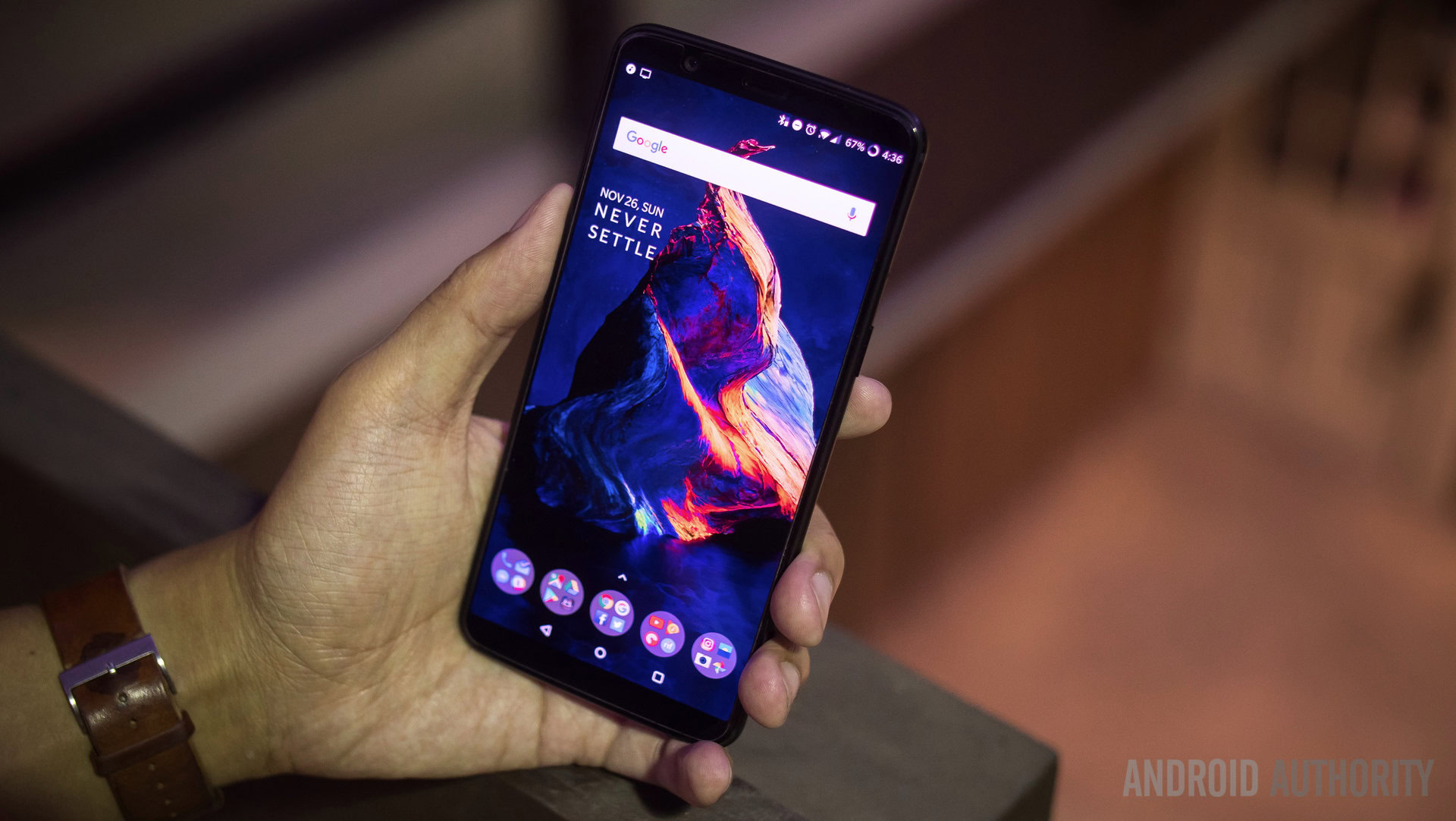
Personalization, however, is one of the high points of the Razer Phone’s UI, thanks to a partnership with a very popular third party launcher – Nova Launcher. With a Prime license included, there are a ton of possibilities for customization in the interface: icons, swipe gestures, and icon grid sizes only scratch the surface of what Nova Launcher fans have long enjoyed. Razer keeps everything else pretty stock, just with a splash of Razer green thrown on top.

Specs
| Razer Phone | OnePlus 5T | |
|---|---|---|
Display | Razer Phone 5.72-inch IGZO LCD 1440 x 2560 resolution 513 ppi 16:9 aspect ratio 120 Hz, Wide Color Gamut (WCG) Corning Gorilla Glass 3 | OnePlus 5T 6.01-inch AMOLED 1080 x 2160 resolution 401 ppi 18:9 aspect ratio Supports sRGB, DCI-P3 2.5D Corning Gorilla Glass 5 |
Processor | Razer Phone Qualcomm Snapdragon 835 Mobile Platform | OnePlus 5T Qualcomm Snapdragon 835 Mobile Platform |
GPU | Razer Phone Adreno 540 | OnePlus 5T Adreno 540 |
RAM | Razer Phone 8 GB dual channel LPDDR4 1,600 MHz | OnePlus 5T 6/8 GB LPDDR4X |
Storage | Razer Phone 64 GB UFS microSD expansion up to 2 TB | OnePlus 5T 64/128 GB UFS 2.1 2-lane No microSD expansion |
Cameras | Razer Phone Rear cameras: 12 MP wide-angle sensor with f/1.75 aperture, PDAF 12 MP zoom sensor with f/2.6 aperture, PDAF Dual tone, dual LED flash Front camera: 8 MP fixed focus sensor with f/2.0 aperture | OnePlus 5T Rear cameras Main sensor: 16 MP Sony IMX 398 sensor, 1.12 µm, f/1.7 aperture, 27.22 mm focal length Secondary sensor: 20 MP IMX 376K sensor, 1.0 µm, f/1.7 aperture, 27.22 mm focal length Front camera: 16 MP Sony IMX 371 sensor, 1.0 µm, f/2.0 aperture |
Audio | Razer Phone Stereo front-facing speakers Dual amplifiers Audio adapter with THX-certified DAC | OnePlus 5T Bottom-facing speaker Three microphones with noise cancellation Supports AANC Dirac HD Sound |
Battery | Razer Phone 4,000 mAh Non-removable Qualcomm QuickCharge 4.0+ | OnePlus 5T 3,300 mAh Non-removable Dash Charge (5V 4A) |
IP rating | Razer Phone None | OnePlus 5T None |
Network | Razer Phone GSM: Quad-band GSM UMTS: B1/2/3/4/5/8 LTE:B1/2/3/4/5/7/8/12/17/19/20/25/26/28/29/30/66 TDD LTE: B38/39/40/41 TD-SCDMA: B34/39 | OnePlus 5T LTE: Supports 3xCA Supports 64QAM & 256QAM Supports up to DL CAT 12 (600 Mbps) / UL CAT 13 (150 Mbps) depending on carrier support Bands: FDD LTE: Bands 1/2/3/4/5/7/8/12/17/18/ 19/20/25/26/28/29/30/66 TDD-LTE: Bands 34/38/39/40/41 TD-SCDMA: Bands 34/39 UMTS (WCDMA): Bands 1/2/4/5/8 CDMA: BC0 GSM: 850/900/1800/1900 MHz |
Connectivity | Razer Phone Wi-Fi 802.11 a/b/g/n/ac Bluetooth 4.2 NFC | OnePlus 5T Wi-Fi: MIMO 2x2, 802.11 a/b/g/n/ac, 2.4/5 GHz Bluetooth 5.0, supports aptX & aptX HD NFC GPS, GLONASS, BeiDou, Galileo |
Software | Razer Phone Android 7.1.1 Nougat | OnePlus 5T Android 7.1.1 Nougat OxygenOS |
Dimensions and weight | Razer Phone 158.5 x 77.7 x 8 mm 197 g | OnePlus 5T 156.1 x 75 x 7.3 mm 162 g |
Which comes out on top?
In the end, these two powerhouse phones really show two different philosophies in the Android flagship space – either you really kill it in a particular niche or try to provide all the best in every manner possible. What is so interesting about this comparison is that the OnePlus 5T manages to check so many boxes, but undercuts its competition by at least $100. The Razer phone is an exceptional device that looks different, operates beautifully through its Ultramotion display, and sounds better than most thanks to Dolby certified speakers and a DAC-enabled headphone jack adapter.
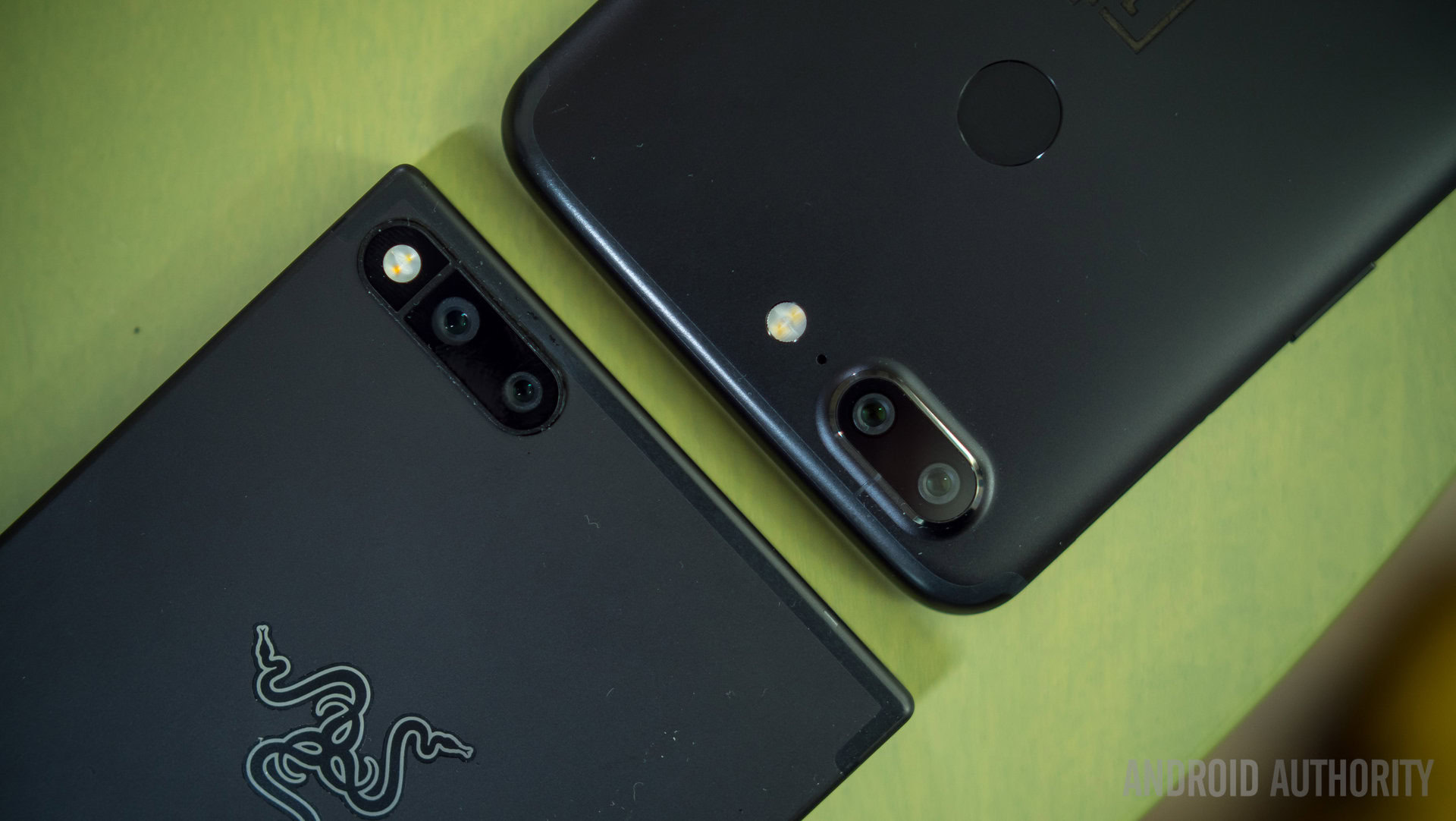
Though the camera is the deepest point of contention in the Razer Phone, we would not be surprised if some users sidestep it in favor of a one-of-a-kind media consumption experience. We really think Razer has something on their hands and companies like OnePlus could construct their own implementation of it in the future. After all, OnePlus has done so with the fingerprint reader, dark modes in the UI, Oxygen OS, Face Unlock, portrait modes, and high spec sheets – making it an easy recommendation if all you need is a great phone without the crazy price.
Which of these high powered devices would you go for? Let us know in the comments below and tell us why!